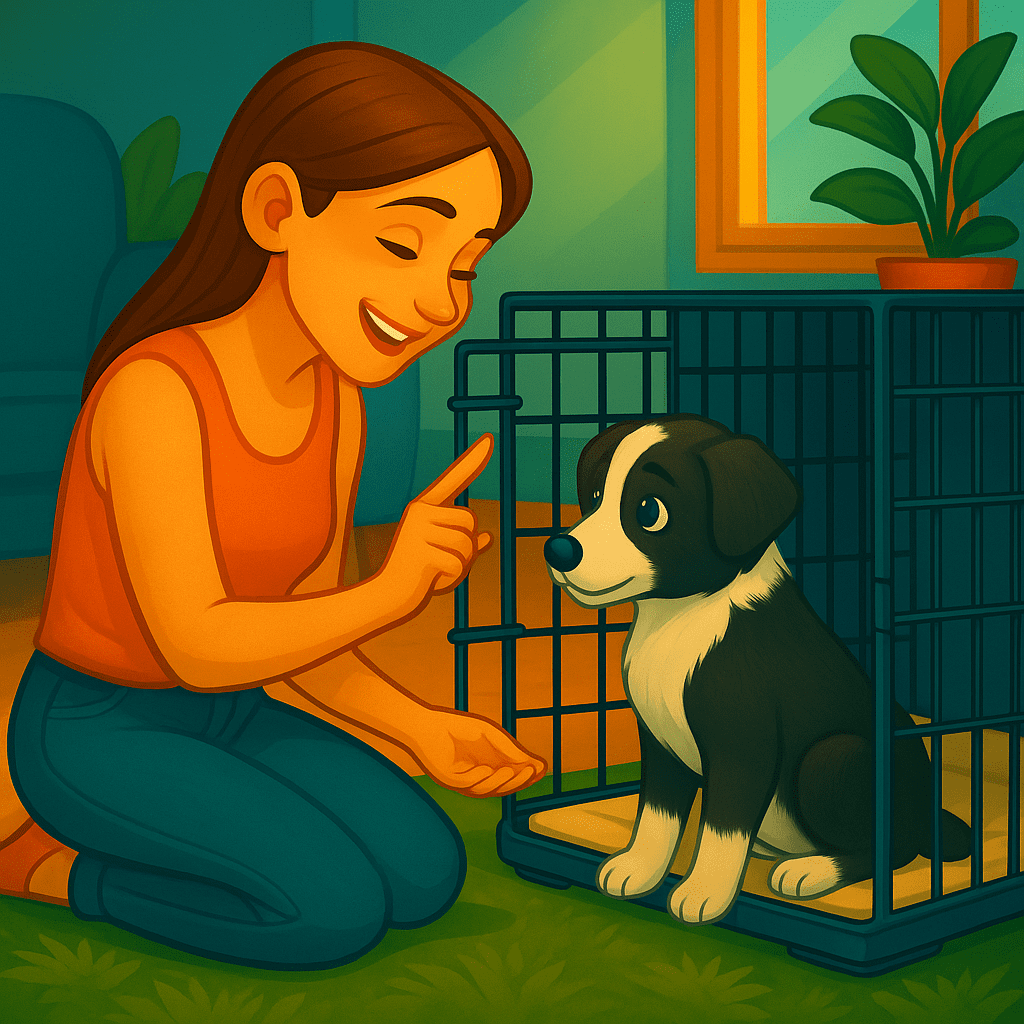
Classical conditioning in dog training
Classical Conditioning in Dog Training
Classical conditioning isn’t just a psychology theory—
it’s one of the most powerful ways dogs learn to feel calm, safe, and secure in our human world.
Pavlov’s famous bell experiment showed how dogs can associate a neutral signal, like a sound,
with something meaningful—like food.
Over time, the signal alone creates an automatic response.
We use the same approach in dog training to help dogs feel better about things that usually make them anxious—
like strangers, crates, car rides, or the vet.
🧠 Why It Works
Dogs don’t need to think about it—
their brains are wired to make connections between what happens and how they feel.
When a neutral trigger (like a doorbell or leash) is consistently paired with a reward (like a treat),
your dog starts to expect something good.
This changes how they feel before they even react.
At PupCommand, we use classical conditioning to turn fear into trust,
hesitation into joy, and stress into confidence.
It’s not about obedience.
It’s not about control.
It’s about helping your dog feel safe—automatically.
Whether your puppy is nervous around new people,
or your rescue dog panics when you pick up the leash—
classical conditioning gently rewires their emotional response.
Creating safety without force.
classical conditioning gently rewires their emotional response—
creating safety without force.
- 🔔 A neutral trigger (like a doorbell)
- ➕ A positive experience (like treats or praise)
- ✅ Creates an emotional response (excitement, calm, trust)
Over time, your dog starts feeling safe and secure even in situations that once caused fear.

🟠 Classical vs Operant Conditioning: What’s the Difference?
I’ve worked with dogs across every temperament—fearful rescues, hyperactive pups, and everything in between. One question comes up again and again: what’s the real difference between classical and operant conditioning? It’s easy to mix them up, but understanding how they work is key to effective training.
Classical conditioning in dog training builds emotional associations. Operant conditioning, on the other hand, shapes behavior through consequences. Knowing which one you’re using—and when—can be the difference between confusion and lasting progress.
Classical conditioning in dog training builds emotional associations. Operant conditioning, on the other hand, shapes behavior through consequences.
👉 If you’re unsure which method your dog needs, read our Positive Reinforcement guide for a clear breakdown »
Here’s the breakdown — no psych degree required.
⚖️ Classical Conditioning:
- 🎯 Focuses on emotions and associations
- 🧠 Happens before a behavior — involuntary
- 🐾 Example: A dog hears the leash click and gets excited before the walk even starts
⚙️ Operant Conditioning:
- 🚀 Focuses on choices and consequences
- 🔄 Happens after a behavior — voluntary
- 🐾 Example: A dog sits, gets a treat — more likely to sit again
🟠 How to Use Classical Conditioning to Build Trust
Trust doesn’t come from control — it comes from emotional safety. Classical conditioning in dog training lets you create that safety by pairing something scary or unfamiliar with a consistent, positive outcome. A treat after a doorbell. Calm praise when entering the crate. Repetition builds emotional confidence.
Over time, your dog stops dreading the crate, the bath, or the car. They start to expect good things. That’s the heart of trust-building: not forcing behavior, but reshaping how your dog feels in those moments.
🧠 What to Pair:
Pair the scary with the positive — like a stranger’s approach with a high-value treat.
📦 Start Small:
Begin with low-intensity versions of the trigger. Crate door open, no closing. Vet table without exams.
🔁 Repetition Matters:
Repeat often, and always follow the trigger with the reward — in the right order.
📈 Watch Body Language:
You’re aiming for soft eyes, loose body, wagging tail — not perfection.
🔄 Be Consistent:
Skip it once, and trust takes a hit. Consistency creates predictability, which builds emotional security.
🟠 Quick Chart: Classical Conditioning at a Glance

🟠 Frequently Asked Questions: Does Classical Conditioning in Dog Training Work for All Dogs?
❓ What exactly is classical conditioning in dog training?
Classical conditioning in dog training is the process of creating associations between a neutral stimulus (like a bell or crate) and a meaningful one (like food or praise). Over time, the dog begins to respond to the neutral stimulus as if it were meaningful—because it predicts something important.
This is the foundation behind fear-free training. Instead of forcing behavior, you change how the dog feels about something.
❓ Is classical conditioning just for puppies?
No—it works for dogs of all ages. While puppies may form associations more quickly, older dogs are still learning every day. In fact, classical conditioning is often essential for rescue dogs, trauma survivors, and dogs with fear-based behaviors, because it helps reshape emotional responses without pressure.
❓ Can classical conditioning fix behavior problems?
It depends on the problem. Classical conditioning in dog training doesn’t directly teach behaviors like “sit” or “stay” (that’s operant conditioning), but it lays the groundwork. It helps eliminate fear, anxiety, or hesitation that often blocks learning. It’s a game-changer for:
- Crate training
- Vet/groomer visits
- Leash reactivity
- Noise phobias
🧠 Want to explore the science behind classical conditioning even deeper?
Visit American Veterinary Society of Animal Behavior — a leading authority trusted by professionals worldwide. Their position statements break down behavior science in clear, evidence-based terms.

❓ What if my dog doesn’t seem to respond to it?
Most likely, your timing or consistency needs adjustment. For classical conditioning to work:
- The positive experience must come immediately after the trigger
- The trigger must stay neutral (not scary or too exciting)
- The pairing must happen repeatedly, without negative interruptions
Example: If your dog sees a crate → gets a treat → then gets locked in for 6 hours, the treat won’t help. But if the crate always predicts comfort, rest, and rewards? The crate becomes a safe space.
❓ How long does it take to work?
It varies, but early changes can appear in days or even minutes—especially with food-motivated dogs. That said:
- Deep fears (like past abuse) may require weeks or months
- The key is small wins stacked daily
Training doesn’t fail because it’s slow. It fails when it’s inconsistent.
❓ Can I use it wrong?
Yes—but it’s fixable. Classical conditioning is always happening. If a leash predicts stress (like punishment or chaos), your dog will associate it with fear. That’s why it’s so important to:
- Control the associations your dog is making
- Stay calm, predictable, and rewarding
❓ How does it compare to operant conditioning?
Great question. In short:
- Classical = emotions (how your dog feels about something)
- Operant = actions (what your dog does in response)
They work best together. Classical creates the emotional foundation. Operant shapes the behaviors. You can’t build trust without the first, and you can’t teach skills without the second.
❓ Should I combine classical conditioning with other training methods?
Yes—but carefully. The most effective programs combine:
- Classical conditioning to build emotional safety
- Positive reinforcement to teach skills
- Management strategies to avoid setbacks
Avoid punishment-based methods that risk triggering negative associations—these directly sabotage classical conditioning in dog training.
❓ Is classical conditioning science-based?
Absolutely. Classical conditioning in dog training was first described by Ivan Pavlov in 1897 and has been validated by over 100 years of research. Modern neuroscience confirms that pairing positive outcomes with neutral stimuli changes how the brain reacts to stress, fear, and novelty.
❓ Can I use it myself, or do I need a professional?
You can absolutely do it yourself—especially for basic trust-building. Just make sure you:
- Reward early and often
- Keep sessions short and consistent
- Avoid pairing the trigger with fear or frustration
For complex cases (like aggression or extreme fear), a force-free trainer can customize the plan and help with timing.

📚 Want to Master All 5 Training Principles?
Each method builds on the others. Explore them all to truly understand how dogs learn — and how to train with clarity, confidence, and compassion.
🎁 Ready to test your skills?
Get the Free Quiz Pack
